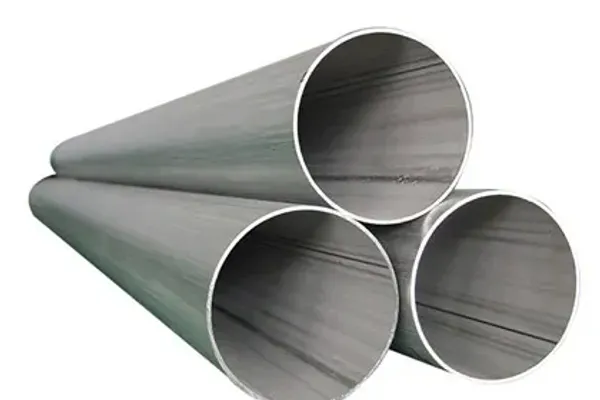Picking the wrong material or size stalls builds. Rework, leaks, and missed inspections follow. Choose the right welded stainless option and projects move on time.
Welded stainless steel tubing is formed from strip, closed with a controlled seam, and finished to precise dimensions. It is consistent, cleanable, and usually more cost effective than seamless for standard sizes. Specify grade, OD, wall thickness, and length with the proper specification. Use it in food and beverage, medical devices, construction frames, and instrumentation where corrosion resistance and fast delivery matter.
In simple terms, we form a strip into a round shape and weld the edges to make a continuous tube. The seam is narrow and stable after sizing. This guide covers welded stainless steel tubing and when to apply it well.
By contrast, seamless routes start from a pierced billet and produce a round tube without a seam. Seam-free stock suits very high pressures and small diameters. For most programs, welded wins because it runs from coil at line speed and lands predictable sizes; compared to seamless, it often ships faster and at lower piece cost.
Key differences
| Route | Range of OD | Typical wall | Bitirmek | Relative cost |
| Welded | Broad | Thin–medium | Bead-rolled, ground | Lower |
| Seamless tubing | Narrow–medium | Medium–thick | Hot-finished, cold-drawn | Higher |
“Pick the route that fits pressure, finish, and compliance—there’s no one-size-fits-all rule.”

kaynaklı paslanmaz çelik boru
For precise seams we use GTAW (TIG welding), a type of arc welding with a tungsten electrode and inert gas shield. Depending on gauge and duty, we may add filler metals. Cold finishing aligns the seam, and controlled heat treatments relax stress so the section stays ductile.
Many lines run welded and drawn: after welding, the product is pulled over a mandrel to equalize properties and tighten tolerance. Proper purge, bead conditioning, and pickling protect korozyon di̇renci̇ and stable passivation so assemblies last in wash-down and outdoors.
“A well-made seam can match the parent metal’s performance for most demanding applications.”
The default steel alloy for general service is 304 stainless because it balances formability, high strength, and cleanability. For hot-cycling parts, stabilized grade 321 reduces carbide precipitation at the seam. Each alloy responds differently to heat and load; choosing early keeps hardware simple and reliable.
Stainless steel tubes are often selected when chemicals or weather are present because the austenitic matrix resists oxidation. For tight-bore work in instrumentation ve medical devices, ask for cold drawn tubing to refine the bore and surface. We also support custom alloy tubing when niche media or temperatures demand it.
Quick grade snapshot
| Sınıf | Type | Highlights | Typical uses |
| 304/304L | Austenitic | Easy to form and join; excellent hygiene | Frames, conveyors, clean water |
| 316/316L | Austenitic | Extra molybdenum for chlorides | CIP washdown, marine |
| 321 | Austenitic | Ti-stabilized for thermal cycling | Exhaust manifolds, heat shields |
| 201/202 | Austenitic | Cost-sensitive, check service limits | Light architectural |
| 409/430 | Ferritic | Magnetic, lower nickel | Decorative skins, trim |
When you specify a line, list OD × wall thickness × length, grade, finish, and the governing specification. Standard tubing sizes follow ASME and ASTM tables. If the tube must match a ferrule or pipe thread, add that note to avoid fitting issues or coupling gaps during install.
Sizing quick view
| Use case | OD | Wall (mm) | Standard length |
| Handrail fabrication | 38.1 mm | 1.5 | 6 m |
| Clean-process transfer | 25.4 mm | 1.2 | 6 m |
| Structural bracing | 50.8 mm | 2.0 | 6–12 m |
Tube offers repeatable outside dimensions for clamps and holders, making layout simpler. Where the seam location matters for sensors or brackets, mark a clocking note so the seam sits on the calm side of flow.
In food and beverage plants, smooth seams improve cleanability and uptime. 304 stainless steel tubing is a staple for frames and conveyors. In labs and small devices, tidy seams with drawn finishes keep flow steady for dosing. In construction, frames and guards cut clean and fabricate fast with predictable stock.
In the aerospace ground-support world and high-end carts, bent sections carry light weight with strong stiffness. Because the production process runs from slit raw material through welding and finishing on one line, traceability stays intact. That traceability shortens audits and helps teams buy with confidence.

paslanmaz çeli̇k uygulamasi
Finish choices depend on service. As-welded suits most frames. For hygienic tubes, the ID bead can be removed and the ID conditioned before a final polish. Proper passivation keeps stainless steel welded surfaces bright even after wash-down.
Architectural work prefers brushed or mirror skins. Document Ra targets where regulators require them and tie each lot to a written specification. Visual standards speed sign-off in the field.
From coil to finished stick, welded lines run continuously and stack straight lengths efficiently on a truck. This makes them cost effective for volume buys. Seamless keeps a place for extreme pressure or thick walls, but many buyers prefer welded once the math is laid out.
Because tube manufactures vary by region, we plan manufacture to protect lead time and keep grades consistent. Shared mill slots, balanced MOQs, and aligned specification language ensure the base material matches certs across lots. Your procurement team gets predictable products and services with fewer surprises.
“Use welded where speed and consistency pay off; reserve billet-drawn routes for truly extreme duty.”
For shop work, keep torch angle steady and purge well; add filler metals only when joint fit-up calls for it. Thin gauges bend best with internal supports. Heavier gauges like careful heat control so frames stay square during weld steps.
On site, saw-cut ends, deburr, and dry-fit every coupling or fitting before tack weld. Where ferrules join to pipe, verify sealing faces. If vibration is likely, place the seam away from bend peaks and check color after work; straw or blue hues may show heat or purge concerns.

Fabrication, fitting, coupling, and field practices
Quality starts at the slit edge of the raw material. Cameras watch the seam as we weld; gauges check OD, wall, and run-out. Cold finishing and heat treatments tune grain so the section stays ductile. Eddy-current and hydro tests validate integrity before cut-to-length.
We record specification results and heat numbers so traceability stays intact from base material to finished stock. For regulated lines, we can archive samples so you can retrieve them later if a customer requests proof.
Before you order, list the grade (304 stainless, 321), required OD, target length, end prep, finish, and the exact specification. Add destination, required documents, and packaging. If the system ties into stainless steel pipe or steel pipe, include that note so interfaces match. If you also run carbon steel in the same facility, state segregation needs.
We support drawings, PPAP on request, and serialization. Our team can fabricate prototypes to confirm fit, then kit production parts for faster installs. If your bill calls for stainless steel welded tubing in one skid and stainless steel welded tubing alternatives in another (for test lines), we label and palletize to your plan.
A regional integrator needed hygienic frames for a packaging line restart in 15 business days. Seam-free product would miss the window. We proposed welded tubing with ID bead removal, 180-grit finish, and certified Ra ≤ 0.8 μm. By aligning sizes to stock tables and agreeing on a tight but fair tolerance, the crew installed in two nights and passed swab tests on the first run.
Common call-outs
| Call-out | Meaning | Why it matters |
| 25.4 × 1.2 × 6000 | OD × wall × length (mm) | Fewer re-cuts, faster layout |
| A269 TP304 | ASTM material code and grade | Matches QA documents |
| ID bead removed | Hygienic internal surface | Cleanability, flow |
| Brushed No. 4 | Outer finish | Aesthetics, feel |
| 3.1 certs | Mill test certificates | Traceability |
Finish quick guide
| Bitirmek | Typical use | Note |
| As-welded | Frames, guards | Strong, economical |
| Bead-rolled | Food contact support | Smooth ID, easier to sanitize |
| Mirror | Architectural | Best appearance, hardest to maintain |
Is welded as strong as seamless for frames?
For most frames and flow lines, yes. With bead conditioning and finishing, the seam can meet design loads. Use seamless stainless only for very thick walls or ultra-high pressure.
Which standard covers sanitary welded material?
ASTM A270 is common for sanitary; ASTM A249/A269 cover many process tubes. Always attach a written specification that mirrors your regulator’s expectation.
Can I bend welded 304 without cracking?
Yes. 304 is austenitic and quite ductile. Use a proper bending die and, for tight radii, internal mandrels and lubricant. Cold work raises strength, so verify loads afterward.
What finishes are available?
Options range from as-welded to mirror. In clean rooms, confirm Ra and bead removal. Outdoors, passivation improves corrosion control and keeps surfaces bright longer.
When should I choose welded over other routes?
Pick welded for volume, predictable sizes, and speed. Pick seamless for extreme pressure, very small diameters, or after heavy machining. Many systems blend both.
Do you supply custom cut and kitted assemblies?
Yes—we cut, deburr, label, and kit per drawing so installers can bolt up quickly. That keeps sites cleaner and reduces lost parts and rework.
We are a professional stainless steel manufacturer and exporter based in China. For industrial distributors, fabricators, OEM/ODM product manufacturers, infrastructure developers, and B2B buying offices, we deliver consistent, documented tubing so your projects stay on schedule.
Paslanmaz Çelik Boru Üreticileri: Dikişsiz, Alaşımlı ve Paslanmaz Çelik Boru Açıklaması
Kaynaklı Paslanmaz Çelik Boru ve Tüp: 304 Paslanmaz, 321, Dış Çap/Duvar Kalınlığı ve Boru Özellikleri
Paslanmaz Çelik Küpeşte Tasarımı:Merdiveniniz için Paslanmaz Çelik Küpeşte ve Korkuluk Fikirleri
Mobilya için En İyi Paslanmaz Çelik Boru Hangisidir? Çelik Boru ve Çelik Boru Kılavuzu (Metal Mobilya) - Doğru Tedarikçi Nasıl Seçilir